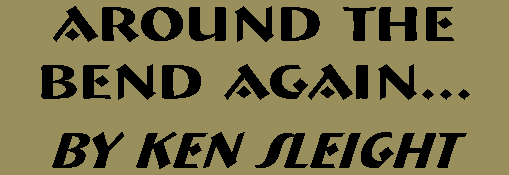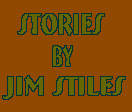

THE 1940'S: THE SHAPING OF A LIFE
Jim Stiles's selection theme of the “40's” for this issue lends me another opportunity to reminisce a bit as my life takes on new meaning at the passing of each ten years or so. My first decade (1929-1939) was spent growing up in Idaho. My second decade of life (1940-1949) was set in Utah. Incidences, experiences, environment, and heritage all shape one’s life, and so, pardon me as l divert a bit from my usual issue-oriented columns to touch upon some of my own personal ventures.
I was only eleven years of age, when in 1940 our family moved to Utah. Dad had just purchased a 60-acre farm at Woods Cross, a farm community eight miles north of Salt Lake City.
I had treasured my days in the Bear Lake valley of Idaho, as it was a great place to grow up. However, the Great Depression and the hard economic times had placed many challenges on us. Those times were my own “pioneer days.”
There were seven kids in our family--Maxine, myself, Ray, Roy, Edward, Frank, and Gayle in that order and we all pitched in and had our respective chores and work to do.
In my work, I came to know the value of water. Our water system came from local springs from which we filled a reservoir for drinking purposes and irrigated our crops with the remainder. The job of irrigation was mine.
We were pretty well self-sufficient. We had a large garden and planted many varieties of fruits and vegetables. We’d trade with neighbors or at the markets if we wanted something we didn’t have.
Things were not as we had in Idaho. Left behind was the wood-burning kitchen stove, replaced by an electric one. No longer were we kids cooped up in but one bedroom and the hallway, but we now had three bedrooms. And we had two bathrooms rather than just one.
Our crops consisted mostly of fruit trees: apricots, peaches, plums and prunes. Row crops were numerous: melons, peas, beans, corn, tomatoes, strawberries, asparagus. We grew wheat and oats, and alfalfa. And we had flocks of chickens and many straying turkeys. And with this we had plenty to eat. We'd have “down-on-the-farm” meals: meat, potatoes and gravy. And lots of eggs: scrambled, fried, and poached.
We’d sell our produce to the Woods Cross Canning Company, the farmers market in Salt Lake, or at our roadside fruit stand. I spent many hours manning the fruit stand while fighting off the flies.
There were always jobs to do. We worked a team of horses-- Kit and Kate--and the machinery was horse driven. Not until one of us accidentally killed both horses by leaving the grain-bin doors open did dad buy a tractor--a small Allis Chalmers thing. To start it, we had to crank it, and it kicked like hell, “knocking some sense into us” as grandpa would say.
We developed our own sports: sledded, tobogganing, and with slat board skis we skied the foothills behind us. Tiring of that, we’d ride the calves and hogs.
War seemed imminent and threatening to us in 1940 as the Nazi armies seized much of Europe Nothing like a war to override the depression.
Our evening ritual was sitting on the front porch to watch the beautiful sunset over the Great Salt Lake. Grandpa would sit there with us too. He was quite deaf, and we had to yell at him to make him hear. His deafness didn’t stop him from talking, but with no teeth he was not always easy to understand either. He would often mumble "I guess maybe I'll go to Salt Lake tomorrow" With his small satchel, he’d go down on the highway, stick out his thumb, and hitch a ride to Salt Lake to walk the streets and visit the bars. In a few days after having his fill he’d return home.
Politics always interested me. I remember the presidential race of 1940 when the Democrats nominated Franklin D. Roosevelt again as its presidential candidate, and the Republicans nominated Wendell L. Willkie. Willkie, closely allying himself with big business, attacked New Deal policies as “dictatorial regimentation.” “Willkie will keep us out of war,” dad reiterated in his Republican voice, but Roosevelt had been a father-figure to me.
I loved the movies. The closest movie house, the Queen Theater, was in Bountiful. I was happy to walk the three miles to see John Ford’s great movie, Stagecoach, a movie about taming the wilderness. It dealt with an evocative period of Western American history that counseled a return to nature and other simple concerns. Also, it introduced John Wayne to the world.
Another great one starred Henry Fonda as Tom Joad, in the Grapes of Wrath. John Ford, in adapting it from John Steinbeck's novel, concerned himself with the eviction of a dust bowl family of Oklahoma in its search for jobs and justice in the promised lands of California.
On my twelfth birthday, I attended “Mutual,” a Mormon kid’s social organization. There I joined the Boy Scout program. It was fun and the Mormon thing to do, and there were lots of outdoor excursions and camp-outs. We’d make occasional trips to Saltair at Great Salt Lake by hopping onto the open-air railroad cars. We’d joyfully swim and float in the briny Salt Lake and then spend long minutes showering the itchy and sticky salt-crust off. And of course while there, we’d ride the huge wooden roller coaster which gave us hard, thrilling, and bumpy rides out over the Great Salt Lake.
During our first school year in Utah, the bus gathered us up each morning to take us to the Stoker School in Bountiful. The school had a small library, the first I had seen since leaving Bear Lake. By this time, my reading ability had so improved that I could digest more advanced texts, such as Will James' highly readable Smoky.
On the home front, I spent much time in our blacksmith shop, and grandpa was there to help me with my projects. He always took old scrap metal parts and made them into something useful, and he repaired the machinery and tools. If he was short of supplies, he would scrounge the nearby local dump. He was a true recycler.
Then came that dreadful and shocking day, Dec. 7, 1941, a day “that will live in infamy.” Hundreds of Japanese warplanes attacked Pearl Harbor Launched from six aircraft carriers they destroyed or severely damaged eight U.S. battleships, eleven other vessels, and 177 Navy and Army aircraft. Over 2,400 military and civilian personnel had been killed, and many were wounded and missing.
Though only twelve I felt the anguish of it so vividly. I saw the anxiety and fear on my parents’ faces as they crowded the radio, their ears turned to catch all breaking news stories. Hirohito and Tojo became hated household words.
President Roosevelt spoke to the nation. Congress declared war on Japan and in a few days also on Germany. The war was now heavy upon us.
But there were a few light moments at school. I had an English teacher that read to us from time to time. One day, she climbed atop her table and stood there animating, expounding and reciting “Gunga Din.” Putting her total self into the attention-getting presentation, language and literature came alive. A beautiful and dynamic lady she was.
Lowell Thomas’s “March of Time,” brought us the war news and played in movie theaters across America spurring us on to buy more U.S. defense stamps and bonds. Grandpa scrounged the dump for metals to contribute to the scrap drive.
One of the most influential movies of that time was Howard Hawks' Sergeant York, starring Gary Cooper. Never had any film up to that time had such an impact on me. It was a story of our nation's most decorated hero of World War I, Alvin York, a Tennessee farm boy and a recounting of the morality of killing during war.
An intensive top-secret program, the Manhattan Project, was launched in 1942 under the direction of the Manhattan District of the Army Corps of Engineers that would have grave consequences for the world. J. Robert Oppenheimer and Enrico Fermi were chosen to create a top-secret establishment at Los Alamos, New Mexico to work on the bomb. Also recruited was John Manley, a physicist from the University of Illinois. Little did I know then, that Manley and his family would, years later, join me on several trips down the rivers and into the canyons. Through the years we became good friends.
On April 12, 1945 when President Roosevelt died suddenly at Warm Springs, Truman succeeded him, and in July he met with Churchill and Stalin at a conference in Potsdam, a suburb of Berlin, to discuss postwar plans. The news of success of the atomic bomb testing program reached Truman in time for the conference. Japan refused to surrender.
On August 4, 1945, U.S. planes dropped leaflets over Hiroshima warning, “Your city will be obliterated unless your Government surrenders.” Truman used its citizens--men, women, children, babies--people who had no power, as hostages.
Two days later, the U.S. dropped its “Little Boy” atomic bomb on Hiroshima! . A terrible holocaust of vast proportions, the news shocked the world. Though I was only 16 years of age, I too fiercely reacted. Why in God’s name? Why? Truman carried out 80,000 instant death sentences on innocent people. So many perished that day, and along with them, and knowingly by our government, some of our own gallant soldiers held in captivity.
And then on August 9, as if one bomb was not enough, he did it again on the citizens of Nagasaki. Leaflets dropped earlier had threatened “a rain of ruin the like of which has never been seen on earth.”
The next day Japan sued for peace, and President Truman proclaimed V-J Day on August 14. The great war was over! Our men were coming home. But to this day I retain a hatred for Truman’s act. Like that of the Holocaust, the horrid nightmare persists.
Congress ended the Manhattan Project in 1946 and replaced it with the Atomic Energy Commission (AEC). The powerful new agency took over the management of existing atomic facilities and the testing of nuclear weapons. The development of the hydrogen bomb was proposed, but David E. Lilienthal, the first AEC chairman and Dr. J.Robert Oppenheimer both fiercely opposed its development. But Truman went ahead with it anyway, and it bothered me greatly.
I spent the winter playing basketball in 1947 with our Orchard Ward team in the Church’s basketball program, and we delighted in taking the championship. Playing basketball was a great diversion for me. I was a good shooter but had problems on the inside. I was always spraining my ankle or getting an elbow in my face.
The FFA (Future Farmers of America) provided me many opportunities at school. One was "writing reports," and I presented one of my best to a forum of judges. It was a subject I knew well, “Cutting Down Erosion by Contour Plowing.” It was my first environmental piece.
After graduation, some of us in the FFA class took a trip by school bus to the national parks in southern Utah and Arizona, my first trip south to the canyons. My grandmother had told me many tales of southern Utah and the canyons, and I looked forward to it. We visited Bryce Canyon. Great-grandfather George Spencer, a school teacher, had explored that region many years before as he settled the nearby town of Glendale. Out scouting new lands to settle, he met with an accident and died, leaving three wives and a throng of children, at the age of 41.
We visited Zion National Park and walked to the mouth of the Zion Narrows. Little did I know that years later, I’d be leading trips through that beautiful narrow canyon. After Zion we traveled on to Kanab, which once was ruled by an all-woman town council.
Then to the North Rim of the Grand Canyon through the Kaibab Forest to Bright Angel Point. I was ecstatic when I looked down into that great canyon and saw the ribbon of Colorado River. Again little did I suspect then that years later, I’d boat that same river many times.
My new found freedom led me into many places. I especially enjoyed hiking through East Canyon from Henefer and through Emigration Canyon to Salt Lake following the same route traversed by the Donner-Reed party in 1846 and the Mormons the following year.
In my school year at college, I signed up for another series of classes. My courses in physical geology and biology were exciting and instructive. However, my major was destined to be in the business management area, and so I took several business classes which included economics and bookkeeping. Algebra, psychology, health education, and sociology classes helped fill my requirements.
My anthropology class was outstanding. Taught by Dr. Charles Dibble, its subject matter dealt with the treatment of the Indian people of the Great Basin--the Goshute and other tribes.
I was so taken by my geology class that it really affected my future life. Never had a subject moved me so as the historical study of the earth and its landscape. My geomorphology class, taught by Dr. Ray Marsell, provided me many pleasurable times and led me to the canyons.
And my geography class, which dealt with the geography of Utah, gave me much interesting and essential information of our own state. It was one class that I felt I had the knowledge to teach myself. Looking back from this day, I wish that I had majored in Geography as it encompassed so many fields of which I am interested. I would have enjoyed working toward a teaching major. Later classes included many exciting courses. A heavy load indeed. It’s no wonder that it took me six years to get through a four-year course.
I enjoyed my political science class that I took from Dr. G. Homer Durham. It laid the base for a knowledge of the political system we have today. Durham was a dynamic teacher, and from him I developed much of my interest in politics.
My botany class that I took from Dr. Walter P. Cottam, the founder of the Red Butte Garden and Arboretum, was highly enjoyable. He had written a book that he used for his lectures, Is Utah Sahara Bound? and its message still sticks with me.
My whole life seems to have been wrapped up in years of conflicts and wars. First it was the Great Depression, then World War II, then the Cold War, then the Korean War, then the Vietnam War, and now the Environmental Conflicts. But interspersed with these heartaches, there have been many pleasurable incidents and experiences that I will never forget. Whether we are a product of our environment or our heritage, I don’t know, but this is surely an interesting journey.
Those days are but memories now and I’m but a beneficiary of it all, like it or not. So with my well-worn copy of Dale Morgan’s Utah, A Guide to the State, the best guide book ever written about Utah, I’ll continue to head out to explore this wonderful state.





